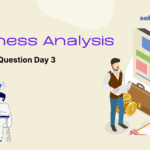Mastering Your Business Analyst Interview Day 2
Introduction:
Welcome back to Day 2 of our Business Analyst interview preparation series! In today’s blog post, we’ll delve deeper into advanced Business Analyst concepts and interview questions to help you further enhance your understanding and readiness for your upcoming interviews as a fresher in the field of Business Analyst . Let’s dive in!
What is the difference between a star schema and a snowflake schema?
Answer: In a star schema, dimension tables are directly connected to a central fact table, resulting in a simpler, denormalized structure. In contrast, a snowflake schema further normalizes dimension tables by breaking them into multiple related tables, resulting in a more normalized but complex structure.
Can you explain the concept of data warehousing and its benefits?
Answer: Data warehousing involves the process of collecting, storing, and organizing large volumes of data from various sources into a central repository for analysis and reporting purposes. Benefits include improved data quality, accessibility, and the ability to perform complex analysis for informed decision-making.
How do you perform data profiling, and why is it important in Business Analyst?
Answer: Data profiling involves analyzing data to understand its structure, quality, and completeness. It helps identify data anomalies, inconsistencies, and patterns, ensuring data quality and integrity in Business Analyst projects.
What are some common data visualization best practices?
Answer: Common data visualization best practices include selecting the right chart type for the data, using clear and concise labels, avoiding clutter, maintaining consistency in design elements, and ensuring accessibility for all users.
How do you approach designing a dashboard for executive-level stakeholders?
Answer: Designing a dashboard for executive-level stakeholders involves focusing on key performance indicators (KPIs), providing high-level summaries, using visually appealing charts and graphs, and ensuring ease of interpretation and navigation.
What are some data modeling techniques used in Business Analyst ?
Answer: Data modeling techniques include entity-relationship modeling (ER), dimensional modeling for data warehousing, and data normalization and denormalization to optimize database performance.
Can you explain the concept of OLAP cubes and their role in Business Analyst ?
Answer: OLAP (Online Analytical Processing) cubes are multidimensional data structures used for complex analysis of data across multiple dimensions, such as time, geography, and product categories. They facilitate fast querying and aggregation of data for business analysis.
How do you handle data security and privacy concerns in Business Analyst projects?
Answer: Data security and privacy concerns in Business Analyst projects are addressed through measures such as role-based access control, encryption of sensitive data, anonymization techniques, and compliance with data protection regulations such as GDPR and HIPAA.
What are some advanced data mining techniques used in Business Analyst ?
Answer: Advanced data mining techniques include clustering analysis, association rule mining, predictive modeling, sentiment analysis, and machine learning algorithms for pattern recognition and predictive analytics.
How do you evaluate the performance of a Business Analyst system?
Answer: Performance evaluation of a Business Analyst system involves assessing factors such as query response time, data processing speed, system scalability, user satisfaction, and adherence to service level agreements (SLAs).
Conclusion:
Congratulations on completing Day 2 of our Business Analyst interview preparation series! By mastering these advanced concepts and questions, you’re well-prepared to showcase your expertise and knowledge in BI during your interviews. Stay tuned for Day 3, where we’ll explore real-world scenarios and practical case studies to further sharpen your skills. Keep up the great work!










